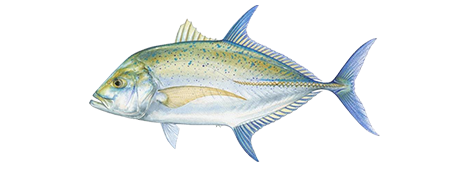Bluefin Trevally

The Bluefin trevally is a large species that can grow to at least 3 feet in length and is among the most beautiful of the jacks or trevallys.
HOW TO IDENTIFY A BLUEFIN TREVALLY
In adults, the back and flanks are a brilliant turquoise blue, silvery blue, or greenish blue, generously covered with small blue or black spots. The tail and other fins may be an even more striking blue than the body. The anal and dorsal fin lobes often are white-tipped and the tail is black edged. Young fish lack spots (including the operculum spot), and have a silvery-yellow body much like that of any other jack species. Even these juveniles are distinctive with their bright yellow pectoral fins and deep blue second dorsal and anal fins. Adult Bluefin trevally are deep-bodied and have strong scutes. The dorsal fin is moderately low, with 8 spines plus one very small spine ahead of the fin. The second dorsal and anal fins are long with prominent anterior lobes. The tail is deeply forked and the pectoral fins are long and falcate. The sloping forehead of this species is distinctive giving this fish a profile that is readily recognizable to those who are familiar with them. Males are slightly larger than females and sexual maturity occurs at a fork length of about 15 inches.
WHERE TO CATCH BLUEFIN TREVALLY
The Bluefin trevally is widely distributed in the tropical and subtropical waters of the Indian and Pacific Oceans. It can be found on the Pacific coast of North America from Southern California, USA and Cabo San Lucas on the southern tip of Baja California, Mexico, south to Panama. It is common throughout Hawaii and Polynesia, occurring in harbors, channels, and on outer reefs. The following list includes additional details on where to catch this fish:
Bays and Estuaries Breakers
Channel Entrances Cliffs
Coastal Waters Deep Shore Water
Man-Made Structure Night Fishing
Reefs, Wrecks, and Shoals Rocky Sea Floor
Saltwater and Tides Shore Points
Surf and Shore Tidal Flats
How To Catch Bluefin Trevally
Bluefin trevally frequent deeper lagoon and outer reef waters during the day. In the evening they enter harbors, channels, and shallow reef areas to feed, and then retreat to the deeper areas. They feed actively on smaller pelagic fishes and other fishes and crustaceans. In the late evening and early morning, they can be caught by surf casters using small fish baits, crustaceans, or lures. These fish are also taken from boats over the inshore reefs with similar baits and jigs, and with spoons and feathers trolled at 3 to 6 miles per hour. The flesh of the bluefin trevally is firm and very good table fare, prized over most of the other species of ulua, or jacks. The following are fishing methods used to catch this fish:
Jigging Drift Fishing Fly Fishing
Bottom Bouncing Bait Casting Surf Casting
Still Fishing Spin Casting Saltwater Trolling